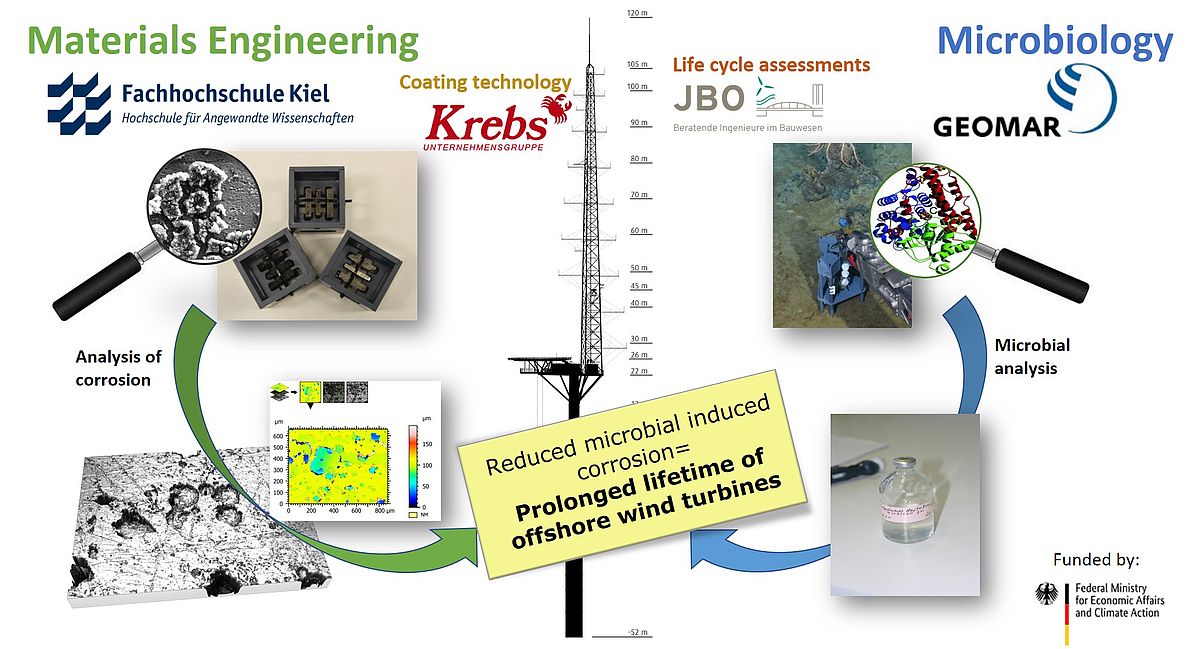Microbially influenced corrosion of iron (MIC) is a widespread problem in the maritime industry, especially for founding structures of offshore wind turbines (so-called monopiles). These are cylindrical hollow piles made of steel that are driven into the seabed and therefore trap seawater, which then exhibits only a limited exchange with the environment. These special conditions have an influence on the microbial activity and biogeochemical processes taking place inside the monopile, which in turn influence the MIC. Due to the specific structural conditions and location of the offshore monopiles, no economically viable, long-term effective and environmentally friendly measures to contain or prevent MIC are currently known. The corrosion protection measures commonly used only address electrochemical corrosion.
As part of the joint project MiCorFe, funded by the German Federal Ministry for Economic Affairs and Climate Protection (BMWK), we are working with partners from the FH Kiel (University of Applied Sciences and industry) to investigate MIC and possible alternative materials and coatings that inhibit MIC in an environmentally friendly way (Fig. 1). To this end, we are carrying out incubations of steel samples in situ, inside the monopile of the FINO3 research platform and ex situ (in the laboratory) (Fig. 2).
![[Translate to English:] Inkubatoren](/fileadmin/_processed_/0/a/csm_Abbildung_Inkubatoren_54a90fed54.jpg)
Figure 2: Fotos of in situ incubators and lab incubations. After a 3-month in incubation at a water depth of 6m, the incubator exhibits a noticeable growth of marine fauna (a). Due to the differing (simulated) environmental conditions, the steel blocks incubated in situ (b, c) and in the lab (d, e) are characterized by distinct corrosion products.
© Lisa Schulz (FuE-Zentrum FH Kiel GmbH) (a), Mirjam Perner (GEOMAR) (b-c), Nicole Adam-Beyer (GEOMAR) (d)
In order to gain a better understanding of the mechanisms involved in MIC and the occurrence of the respective microorganisms at different water depths and to further enable the simulation of the environmental conditions in the laboratory as accurately as possible, the in situ incubations are accompanied by regular measurements of important environmental parameters (such as oxygen content, temperature and hydrogen sulfide concentration of the water) inside the monopile. After completion of the incubations, we identify and characterize the microorganisms involved in the MIC using molecular biological, biochemical and microscopic methods (Fig. 3). In addition, the project partners will create a corrosion model based on the (microscopic) determination of corrosion rates and corrosion products as well as service life calculations.
![[Translate to English:] Mikroskopaufnahmen](/fileadmin/_processed_/4/7/csm_Abbildung_Mikroskopie_603d0a0d29.jpg)
Figure 3: Microscope images of corrosion products. The scanning electron microscope (SEM) images of steel blocks from in situ incubations at water depths of 6 m (a) and 21 m (b) illustrate the differences and the influence of biogeochemical parameters on the corrosion products. Partial figure c shows a fluorescence microscope image of iron oxides with active microbial cells (stained in green) from a laboratory incubation.
© Carolin Skottke, Claus-Henning Solterbeck (FH Kiel) (a-b) & Nicole Adam-Beyer (GEOMAR) (c)
By means of comparative investigations of different materials, coatings and local inhibition hot spots, possibilities for inhibiting MIC are assessed and suitable measures for extending the service life of monopiles in offshore wind turbines will be identified.
MiCorFe-Team
GEOMAR:
Prof. Dr. Mirjam Perner (Project leader Microbiology)
Dr. Nicole Adam-Beyer (PostDoc in the project MiCorFe)
PD Dr. Mark Schmidt (scientist associated with MiCorFe)
FH Kiel / FuE Zentrum:
Prof. Dr.-Ing Jana Schloesser (Project leader Materials Engineering and coordination)
Carolin Skottke (PhD student in the project MiCorFe)
FINO3-Team
Industry partners:
Krebs Korrosionschutz GmbH
Jörss-Blunck-Ordemann GmbH



